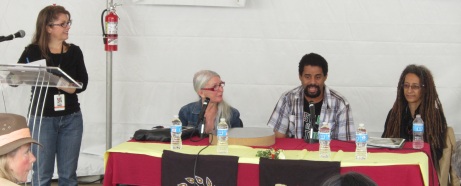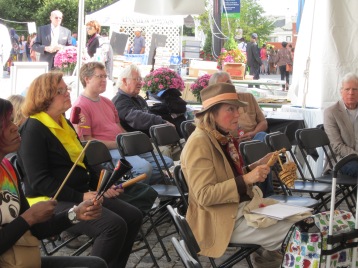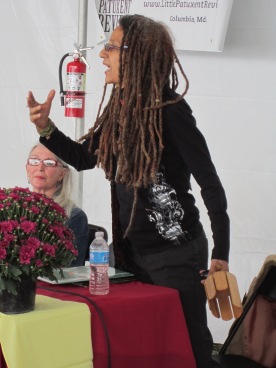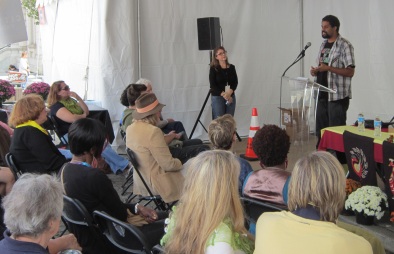Two weeks ago, the Baltimore Book Festival once again brought thousands of people together to celebrate literature in many forms. Virginia Crawford attended not only as visitor, but was at the helm of a panel exploring the place of music in poetry. Here’s what Virginia had to say about the panel and the festival:
This weekend [Sept. 27th-29th] at the Baltimore Book Festival, I had the pleasure of moderating Upbeat: The Music of Poetry in Performance, a panel discussion with three remarkable poet-teachers. The event was in celebration of Little Patuxent Review’s Music issue and to mark the now annual 100 Thousand Poets for Change international celebration. Gregg Wilhelm of CityLit Project kindly hosted myself; Laura Shovan, editor of Little Patuxent Review; Clarinda Harriss, professor emeritus of Towson University and founder and editor-in-chief of BrickHouse Books; LPR contributing editor Linda Joy Burke, a poet and performance artist; and poet Slangston Hughes, one of the slam coaches for the Baltimore City Youth Poetry Team. A great big thanks to CityLit for giving us the time and space for this energizing conversation.
Linda Joy Burke began with a musical session that she often uses to introduce students to rhythm. She distributed instruments to the audience and showed everyone how to play them. The audience investigated their shakers and cow bells and lovely percussive things I can’t actually name. It was an auditory mess. But then Linda Joy stopped everyone and had each person begin playing one at a time, instrument by instrument, filling the spaces or beats created between each other.
This built a quilt of sounds—each instrument or voice holding its own place. She helped create order out of the chaos. Individual voices or sounds could be heard and appreciated. Linda Joy likes to begin this way with students because it can bypass so many things that often get in the way of writing. It connects people to the direct physical experience of rhythm out of which great writing can emerge.
Clarinda Harriss encourages everyone to listen to the rhythms in everyday life—the cadence of a bus, the rhythms inside our own bodies—and invites them to share their own self-made sounds. They might resemble wolf-calls or other beastly noises—they can be anything that has meaning for the students. Then she invites them to write from that voice. They can incorporate the sound into the poem or simply use it as an access point. Either way, the sound takes the writer into another consciousness she might not otherwise have the opportunity to write from.

From left to right, moderator Ginny Crawford and panelists Clarinda Harriss, Slangston Hughes, and Linda Joy Burke. (Photo: Laura Shovan)
When asked how he helps his students create music in their poems, Slangston Hughes said that it was more important to say something rather than something that sounds good. He pointed out that young writers sometimes get caught in the trap of wanting to do it “right” but what they really need to consider is doing it the way it feels right. Strong writing can only come from careful listening to our internal voice—that foundation, if you will. You can have all the ornamental awnings and architectural details in the world (or in this case complex rhyme schemes and a dramatic theatrical performance), but without a strong foundation—something to say—audiences will not be moved.
What listeners really want is to hear your own voice, that thing that only you can produce and fit into the great quilt of life. Linda Joy reminded us that even after a piece is written and revised, when it’s being performed, there should be a sense of listening to the audience. The performance should be a kind of shared breathing between the performer and the audience. Clarinda pointed out the need to speak clearly and slowly so the audience has the chance to hear your music, the song that only you could sing. And Slangston urged us not to just light a torch, not to just say something that sounds good, but to say what we know to be true in ourselves, to set ourselves on fire, to be light.
Virginia Crawford, poet-in-residence with the Maryland State Arts Council, teaches through the Artists-in-Education program. Her book Touch (2011, Finishing Line Press) was featured on WYPR’s Maryland Morning. A graduate of Emerson College, Boston, and the University of St. Andrews, Scotland, Ms. Crawford is co-editor of Poetry Baltimore, poems about a city, and an anthology of student poetry, Voices Fly, with Laura Shovan (2012, CityLit Press).
Editor’s Note: Both Linda Joy Burke and Clarinda Harriss have written about their approach to sound and writing in the past for the LPR blog. Be sure to check out their pieces for still more insights about evoking the music of your own voice.




Clarinda
Thanks for this review, Dylan. You captured the essence of our comments perfectly.
LikeLike
Dylan Bargteil
Thanks, Clarinda. Ginny’s review of the panel only makes me wish I could been in there in person all the more.
LikeLike
Pingback: Little Patuxent Review recaps literature event | BrickHouse Books
Rosalind Heid
I had a wonderful time and made notes.
LikeLike
Dylan Bargteil
I must say that it seems like the panelists really hit some valuable points. Learning to listen and turn on our awareness of our surrounding world, as Clarinda advised, is absolutely important, and reminds me of Kathleen O’Toole’s poem in our Music issue (https://littlepatuxentreview.org/2013/07/09/concerning-craft-kathleen-otoole/). And Linda Joy’s comment about performance also being an act of listening resonates in my mind with Steven Levya’s description of our Minas Gallery reading (https://littlepatuxentreview.org/2013/08/27/perform-all-poems-reflections-on-a-lpr-poetry-reading/).
LikeLike